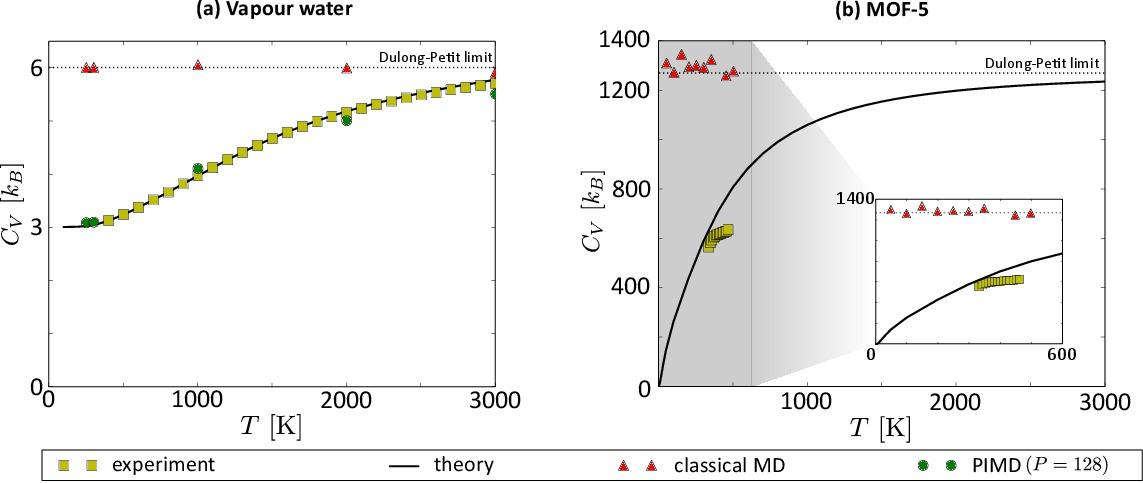Introducing nuclear quantum effects in metal-organic frameworks via a colored-noise thermostat
Introducing nuclear quantum effects in metal-organic frameworks via a colored-noise thermostat
Promotor(en): V. Van Speybroeck /16NANO09 / Nanoporous materialsMetal-organic frameworks (MOFs) are a unique class of porous crystalline materials, which can easily be tuned both chemically and physically for specific applications. These crystals consist of inorganic moieties connected by organic linkers. As in most solid-state physics, nuclear quantum effects are of paramount importance to describe molecular interactions. Despite this, these nuclear quantum effects are almost never included in molecular simulations. However, a quantum treatment of the nuclear degrees of freedom, especially for the light atoms, is required to capture subtle effects as quantum tunneling, deviations from the classical heat capacity due to energy quantization and zero-point effects on mechanical properties. An open question regarding these nuclear quantum effects is to which extent they alter the aforementioned properties.
Although quantum effects can be treated rigorously with path-integral techniques (e.g. PIMD), such simulations are computationally extremely expensive. Instead, other approximations have been suggested such as the colored-noise thermostat by Ceriotti et al. [1, 2] for classical molecular dynamics (MD) simulations. In these simulations, the positions and velocities of the atoms evolve in time by integrating the Newtonian equations of motion and by treating the nuclei as classical particles. While the system evolves, this approximation consists of modifying the velocities of the atoms in such a way that the correct quantum position and momentum distributions of the atoms are enforced. This work is highly relevant as this has never been applied on MOFs or other nanoporous materials in general. The MD simulations will be carried out with force fields, in which the complex potential energy surface is approximated by simplified analytical expressions inspired by simple spring models. During the past few years, the CMM has built up a vast expertise in developing these force fields, resulting in a user-friendly force-field generator code, QuickFF [3].
Goal
In this thesis, the student will perform force-fields based molecular simulations to assess the importance of nuclear quantum effects on the heat capacity and the mechanical behavior of MOFs for the first time. On the one hand, nuclear quantum effects will alter the heat capacity of the material. In Figure 1, the heat capacity as obtained via several methodologies is shown, indicating that nuclear quantum effects are necessary to reproduce the experimental data. Without these nuclear quantum effects, the Dulong-Petit law is already obtained at too low temperatures. On the other hand, the influence of including nuclear quantum effects on mechanical characteristics such as the bulk modulus, i.e. the resistance of a material against deformation, will be investigated. These results will be validated by comparing to experimental data [4].

The colored-noise thermostat is already implemented in our in-house software package Yaff, but it is expected that several parameters will have to be tuned for an optimal performance. The student will therefore have to study the relevant literature on colored-noise thermostats, and implement and validate improvements. As such, this thesis bridges the gap between the physical fundaments (including nuclear quantum effects) and the model development to arrive at the engineering applications of MOFs.
The Center for Molecular Modeling has ample expertise in modeling nanoporous materials and metal-organic frameworks and performs this research in the framework of large-scale international research programs. For these materials, various force fields were developed and applied to successfully predict a multitude of physical and chemical properties. The modeling is performed in close collaboration with both theoretical and experimental partners – including the research team of Ceriotti – to achieve an optimal synergy between modeling and experimental efforts. The student will be actively involved in the work discussions with these international prominent partners. Furthermore, the student will be actively coached to get acquainted as soon as possible with all necessary techniques to perform the suggested research successfully.
Context Engineering
Physics: investigate the influence of nuclear quantum effects on the heat capacity and mechanical behavior of metal-organic frameworks
Engineering: tune the available methodology for an optimal performance
- Study programmeMaster of Science in Engineering Physics [EMPHYS], Master of Science in Physics and Astronomy [CMFYST]ClustersFor Engineering Physics students, this thesis is closely related to the cluster(s) MODELING, NANOKeywordsNuclear quantum effects, heat capacity, mechanical behavior, molecular simulations, Nanoporous materialsReferences
[1] M. Ceriotti, G. Bussi and M. Parrinello, "Nuclear quantum effecst in solids using a colored-noise thermostat," Phys. Rev. Lett., vol. 103, no. 3, p. 030603, 2009.
[2] M. Ceriotti, G. Bussi and M. Parrinello, "Colored-noise thermostats à la carte," J. Chem. Theory Comput., vol. 6, no. 4, pp. 1170-1180, 2010.
[3] L. Vanduyfhuys, S. Vandenbrande, T. Verstraelen, R. Schmid, M. Waroquier and V. Van Speybroeck, "QuickFF: A program for a quick and easy derivation of force fields for metal-organic frameworks from ab initio input," J. Comput. Chem., vol. 36, no. 13, pp. 1015-1027, 2015.
[4] B. Mu and K. S. Walton, "Thermal analysis and heat capacity study of metal-organic frameworks," J. Phys. Chem. C, vol. 115, no. 46, pp. 22748-22754, 2011.

